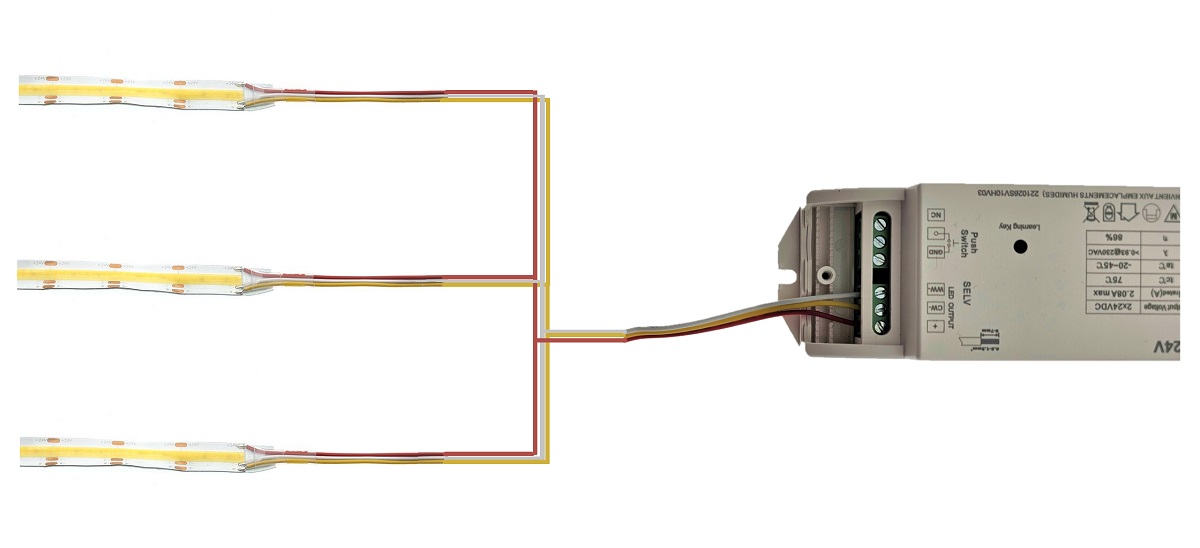This article will cover the topic of “LED strip paralleling” in detail, but I will try to present the information as clearly and understandably as possible.
LED strip light LEDs are in series
An LED strip is a flexible strip consisting of a number of small LED (Light Emitting Diodes), which are connected in series in small groups on the strip. In a series, if one fails, they all go out. Like the traditional Christmas tree lights. 12Led light strip cutting and fault repair instructions here for more information.
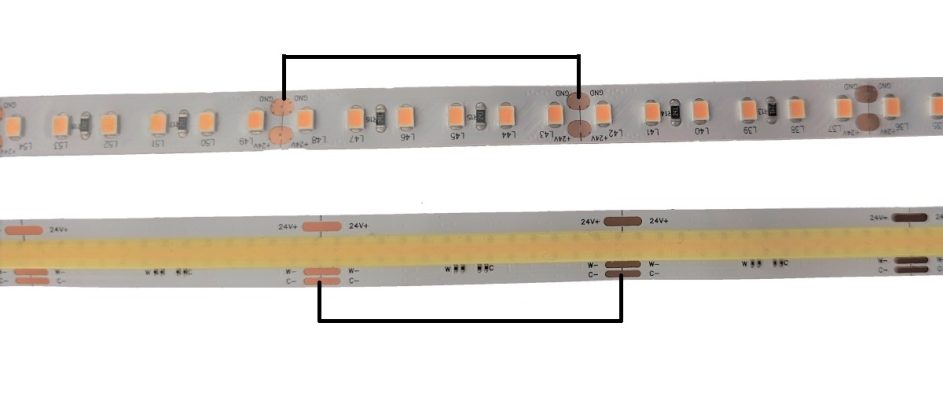
Basics of parallel connection
Parallel connection means connecting several devices (in this case an LED strip light) to the same power supply so that each device receives the same voltage. Connect each colour together.

The advantages of parallel connection include flexibility and reliability: if one device fails, the others continue to work.
Parallel connection of LED strip lights
Paralleling LED strip lights requires some technical knowledge and the right tools, such as a soldering iron and electrical cables. The process involves cutting the light strips to the correct length, attaching the cables to the light strips and finally connecting the cables to the power supply. Always remember to check that the power is off before starting work.
Parallel connection of LED strip lights in practice
For all LED strip lights, first check which is the + (positive) wire. It is always written on the LED strip at the cut-off point. Sometimes the markings are really small, so take a mobile phone picture and zoom in.
And then the rest are – (negative). Negative cables you can put in any order and connect it to the transformer – wire. And the LED strip light comes on.
Negative (minus) wires are found in different types of tape as follows:
There are 1 negative in a single-colour strip
- CCT (colour temperature control) 2 pcs: WW and CV, i.e. warm and cold white
- RGB 3 pieces: red, green, blue and red, green and blue
- RGBW 4 pcs: Red, Green, Blue, White and Blue
- RGBCCT 5 pcs: Red, Green, Blue, Warm and Cool i.e. Red, Green, Blue and Warm and Cool White
So you can connect any one of these wires to the negative and that colour will light up. As long as the plus is connected to the plus.
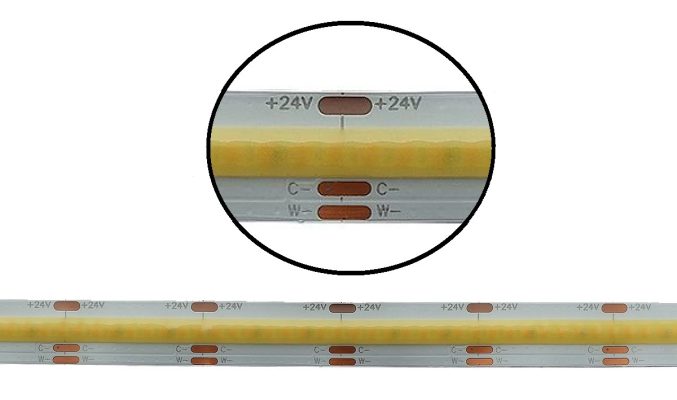
LED STRIP OR DRIVER GENERALLY DOES NOT BREAK EVEN you connect the + and – CROSS. High-quality transformers have short-circuit protection, which means that the light does not just light up because the transformer protects itself. This always happens if – touches the + pole. You may be startled if you hold them in your hand, as they may give off a small spark.
Linking together
Once you have cleared the pluses from all the LED strips, put them together with a sugar lump, Lever connectors, soldering, etc. So all of these will go into the transformer as a plus (+).
Image showing the wires sorted by colour
Then you just repeat the colours on all the LED strips in the same way, so-called colour-colour.
LED strip transformer power calculation
Calculating the size of the LED strip light driver in parallel installation is easy! Let’s take an example where there are 3 pcs 14,4W LED strip lights with lengths of 160cm, 220cm and 240cm.
This is how you calculate the power requirements of the LED strips connected in parallel:
- The LED strip is 14.4W per metre, so it draws 14.4 watts of power (A) per metre.
- Next, calculate the total number of metres connected to the transformer, i.e. 160+220+240 cm = 620 cm, which is 6.2 m
- Then multiply the metres by the power, i.e. 6.2 m x 14.4 W/m = 89.28 W
When calculating the LED driver, it is important to remember to leave a 15-25% power margin for the driver, i.e. the driver should be
89 W x 1.15 = 102 W at its minimum.
Challenges of paralleling LED strip lighting
There are a few things to consider when connecting LED strip lights in parallel.
First, when several light strips are connected in parallel, the power supply must be able to supply enough power to all the strips, as calculated above. Otherwise, all the strips will flash or some will light up dimmer.
Secondly, the light intensity should be uniform across all strips, and this will not happen if one of the LED strips is significantly longer, over 10m, or one of the LED strips has very long supply wires.
In both cases, the cause is a voltage drop, i.e. 24 V on the LED strip may be down to 21 V due to a long supply cable. The cable acts as a resistor for the voltage and long intermediate cables should take into account the increased power demand on the transformer.
Examples of LED strip lighting in parallel
One example of LED strip lighting in parallel is to improve indoor lighting in the home. For example, in the kitchen, several LED strip lights can be installed under the worktops to provide efficient and pleasant light. All these work lights are connected to the same transformer RINNAN.
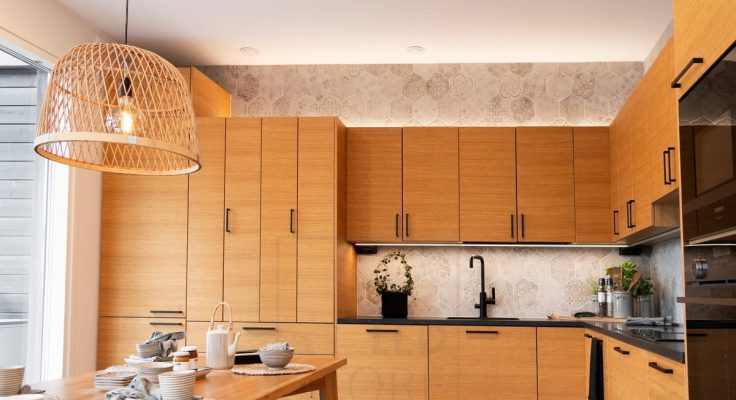
Another popular spot is sauna lighting, where LED strip lights are installed under the table and behind the backrest. In this case, too, both tapes are taken to the same driver paraller.
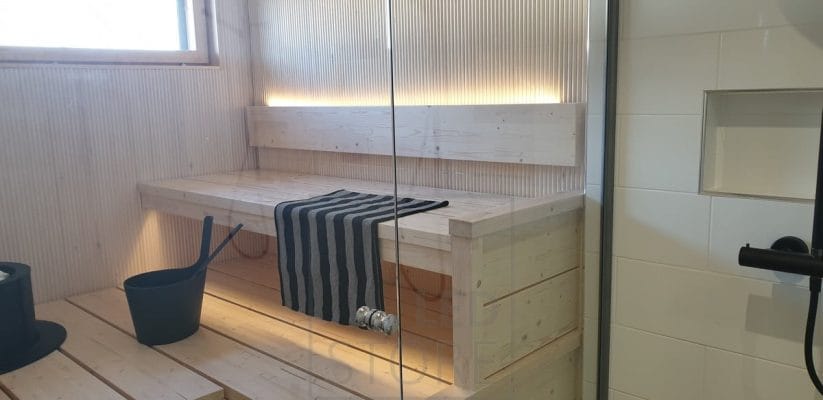
Frequently Asked Questions about LED strip lighting paralleling
What do I do if one of the LED strip lights connected in parallel does not work?
If one LED strip does not work, first check that the strip is intact on all sides and then that the cabling is in good condition.
Can I use different brands of LED strip lights in the same power supply?
Yes, you can use different brands of LED strip lights in the same parallel connection, but make sure they are compatible in terms of voltage (12 or 24 Volts).
How many LED strip lights can you connect in parallel?
The number of LED strip lights you can connect in parallel is mainly limited by the power of the power supply.
Lastly
LED strip lighting offers a flexible and reliable way to improve the lighting in your home or workplace. It requires some technical know-how and the right tools, but has the advantages of light quality, efficiency and continuity of operation even if one tape fails.
It is important to note that each paralleling project is unique and requires its own solutions, so this article only provides a general guideline on the subject.
Led strip light installation guides
- 12Led strip light cut-off – Led strip light cut-off and led strip light replacement
- 12Led strip light does not light – Why does led strip light not light, we go through the reasons
- 12Led strip light flashing – Why does a led strip light flash? There are many reasons and we will go through them all.
- 12Led strip light lifetime – What affects lifetime and why do other strips last longer?
- 12Led strip light mounting – How do I mount a led strip light indoors or outdoors? What needs to be taken into account?
- 12Connecting a led strip light to a transformer – How do I connect a led strip light to different types of transformers?
- 12RGB Led strip light connection – How do I connect an RGB led strip light to different control devices?
- 12Led strip light extension – How do I solder the joints? A little soldering guide for the beginner.
Led strip lighting specialist
LedStore has been an expert in LED lighting and lighting design since 2010. We have our own product design, so our products are technologically state-of-the-art. Products have quarantee for up to 7 years. We also carry out lighting maintenance.
We focus on temperature-controlled and high colour rendering lights, so they work brilliantly and last a long time. We do around 500 lighting designs for our clients’ sites in a year. Read more here or order a design. Did you know?
LedStore offers lighting design from 169 euros for the whole house!
Made to measure Led strip lights
We offer a service of custom-made led strips, i.e. custom-made led strips in aluminium profile. Also installed.
Remember that we are always ready to offer our help to you along the way, by email (myynti@ledstore.fi) and by phone (045 251 4510). As always, feel free to share photos of your own projects on social media at ledstore.fi at Instagram and ledstore.fi at Meta. We love to see the cool things our LEDs do, and it helps to provide inspiration for those who are unsure about the power and awesomeness of LEDs.
Did you know that we already have over 3500 pictures of our LED installations in our Gallery!

